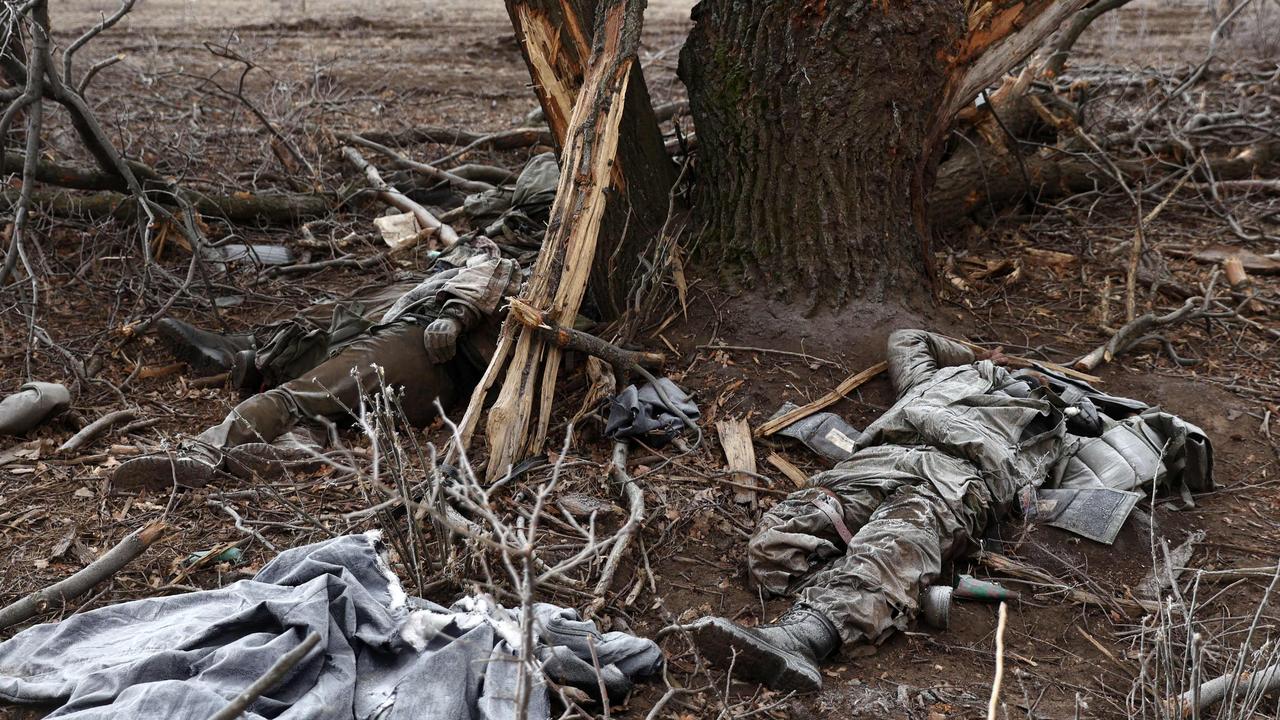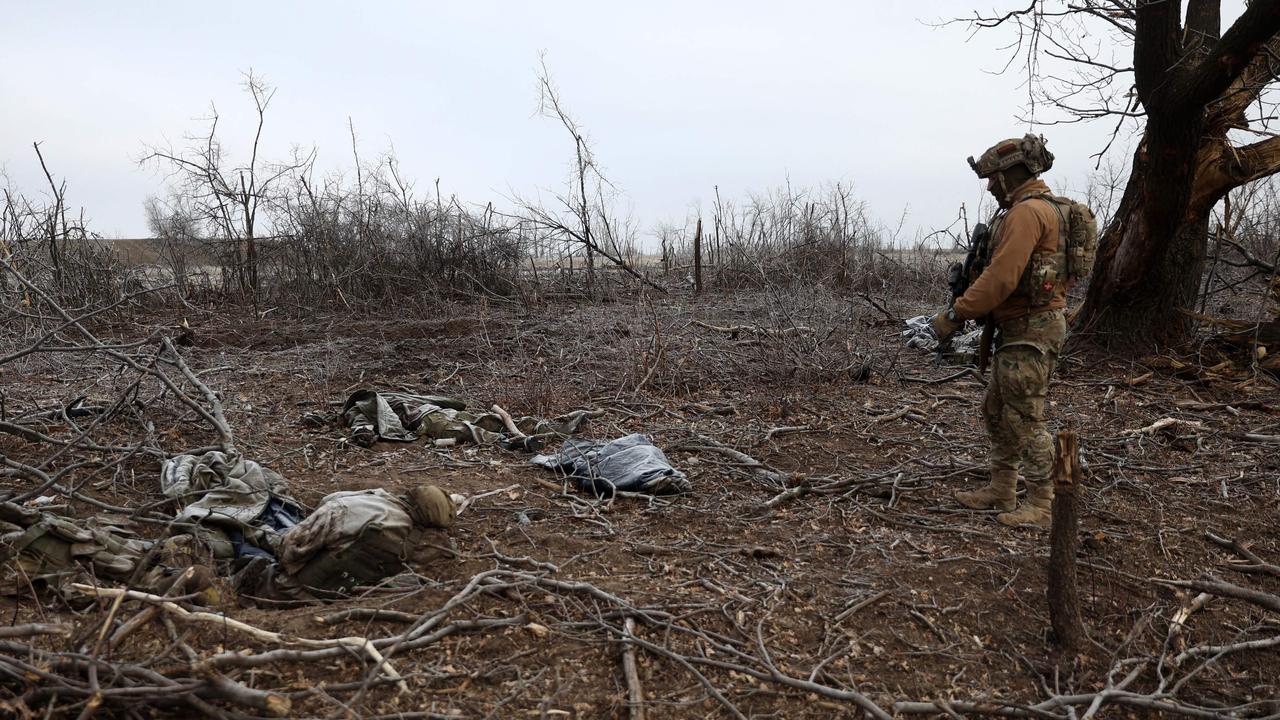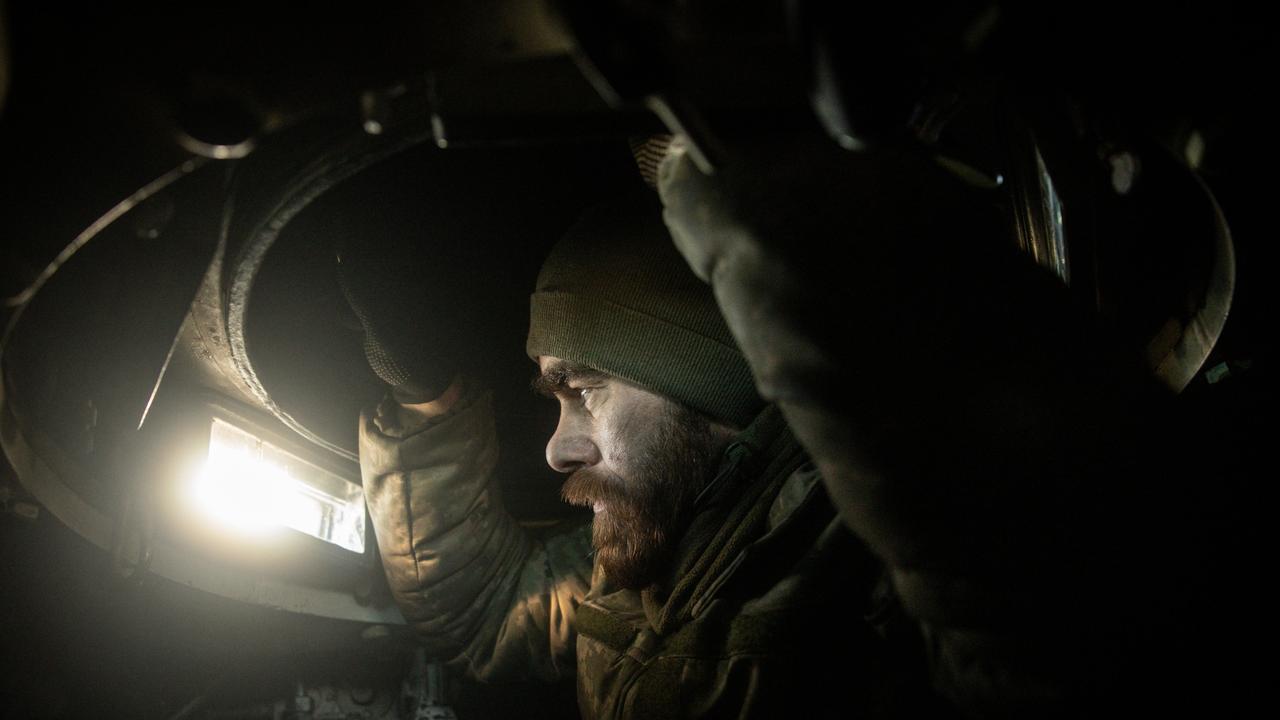Grim photos of dead Russian soldiers thawing out on frontline reveal big problem
Winter is coming to an end in Europe and as the ground thaws, a disturbing reality is being revealed on the frontline. WARNING: Graphic
WARNING: Graphic images
Russia is hurling “meat waves” – hordes of prisoners and poorly trained conscripts – at Ukraine to expose its defenders. But the abandoned bodies of this sacrificial army may soon blow up in President Vladimir Putin’s face.
Winter is coming to an end in Europe. And the spring thaw will ripen more than Ukraine’s crops.
“Overstretched by combat operations, the Russian army is returning few soldiers to their homeland in coffins,” says Flinders University World War I historian Dr Romain Fathi. “Cadavers of Russian soldiers are instead abandoned, piled up, cremated in mobile crematoria or improvised furnaces, hastily buried, or simply left to rot or freeze in the winter months.”

There’s more to this scenario than a lack of hearses and morgues, however.
The Kremlin has long downplayed the death toll among its soldiers in foreign wars, says Dr Fathi. A “missing in action” notification enables Russia not to pay compensations that families are entitled to if a loved one is killed on the frontline.
But the invasion of Ukraine is being fought on an enormous scale.
“Russian losses are beginning to approach around 180,000 dead or wounded soldiers,” Norwegian Chief of Defence Eirik Kristoffersen said earlier this week. He did not detail how this figure was calculated.
Ukraine’s losses aren’t all that far behind. The estimate is about 100,000 troops and 30,000 civilians.

But a change in Russian tactics over winter has seen thousands of troops lined up in trenches before being ordered to rush Ukrainian defensive positions in a manner not seen since WWI.
And most of these bodies remain piled up in the ice and snow.
“The Ukraine war is an oddity for the 21st Century,” Dr Fathi told news.com.au. “The world has worked hard to reduce casualties. Look at Iraq and Afghanistan – the death rates there were much lower than in Vietnam and Korea, let alone World Wars I and II”.
But corpse piles are a very Russian characteristic, he says.
“Traditionally, the Russian army has not considered manpower as something you should take care of. Protecting lives does not have a premium value as it does in Western armies.”
A plague on Putin
“Humans are just another resource like missiles, tanks and helicopters. When dead, they have no value. Therefore, just like helicopters or tanks, the Russian army is happy to leave them lying there. They don’t matter anymore,” Dr Fathi says.
But on one very practical matter, they do.
Health.
Dr Fathi says that a group of one, two or three bodies aren’t a severe problem.
“But when you have hundreds of bodies in confined spaces, they become a serious health risk,” he said. “The corpses putrefy. Bacteria multiplies. This can spread disease to people who handle them and contaminate waterways.”

Tuberculosis. Salmonella. Cholera. Hepatitis and even HIV. All can be spread through contact with corpses.
“It’s not such an issue at the moment as it’s winter,” he says. “The corpses are frozen”.
And while this makes it easier to transport a body, it’s harder to dig into the soil for a quick grave.
“When April comes, if the bodies aren’t collected by then, Ukrainian civilians and the troops of both sides on the front lines will all be exposed,” Dr Fathi warns.
Ukraine, he says, has cause to recover the dead.
It’s not just about health.
It’s also about morale – both their own and in Russia.
“They are the ones who have been invaded,” he says. “So returning a body to a family is a very powerful way to say, ‘We must defend ourselves.’”
But Ukraine is also recovering – and identifying – Russian bodies. And that’s despite Moscow refusing to take delivery of its dead.

So Ukraine is seizing the moral high ground of informing Russian relatives.
It’s also making it harder for Moscow to recruit replacement troops.
“It’s extremely hard to recruit young men if you say, ‘You’re going to die with your face in the mud, and nobody will come for you.’ Which is the reality.”
Moscow’s ‘meat waves’
International analysts are describing the fighting around the city of Bakhmut in Ukraine’s Donetsk region as WWI trench warfare – with 21st-Century characteristics.
Most of the fighting is in Ukraine’s broad and open rural areas.
“This isn’t the type of conflict we’re used to,” says Dr Fathi. “It’s devolved to the level of early last century.”
It’s not guerilla warfare or counterinsurgency. It’s not about surgical strikes.
“Tanks, trenches, artillery, mortars – this is all from a different era,” he says. This is why we see such high death rates: These are not strategic weapons. These are killing machines.”
Trenches have been cut into the frozen ground to provide troops with cover. And the fields are a blasted moonscape.
Tactics have also devolved to the WWI level of sending wave after wave of soldiers out of the trenches to rush enemy positions.


It’s a favoured tactic of the Wagner Group. And the mercenaries have been recruiting from Russian prisons for precisely this reason.
“They push prisoners forward and try to deplete our defence forces so that we run out of ammunition and they can see our firing positions,” Ukrainian armed forces spokesman Captain Viktor Tregubov told local media on Thursday.
The tactic has featured in Wagner’s recent efforts to seize Bakhmut.
But Captain Tregubov says Russia’s professional military has been using similar tactics with its poorly trained and equipped conscripts.
The likely reason is a lack of artillery ammunition.
Russian army doctrine is built around intense barrages of shell fire, with large areas of ground saturated with explosions and shrapnel to suppress any hidden defenders.
But a shortage of ammunition means artillery would have to be reserved for priority targets.
“When they are killed on the battlefield, the Russians see where the shooting is coming from and can, for example, attack our firing points,” the captain explains. “Instead of ‘artillery waves,’ they are launching ‘meat waves’.”
The business of war
“Why are they missing? Where are they? Are they alive? No one can tell, and their missing status can be somewhat convenient in the short term,” says Dr Fathi.
“From a practical point of view, no pension is paid to widows or parents until a soldier is officially declared dead. This is a classic Russian move.”

And mass funerals highlight how Mr Putin’s anticipated “three-day war” to conquer Ukraine has degenerated into a brutal stalemate.
Moscow went to war prepared for a short fight.
Mobile crematoriums were spotted rolling across Ukraine’s border on day one of the invasion. But the scale of conflict soon far outstripped their capacity of eight to 10 bodies a day.
“There are reports these have been used at places like Mauripol to burn the bodies of executed Ukrainian civilians to hide war crimes,” Dr Fathi says. “In Kherson, they resorted to using the city dump to get rid of cadavers.”

Russia has neither the human resources nor the motivation to respect its dead.
“If all the corpses were returned, the Russian population would see first-hand that Vladimir Putin’s special military operation is an immensely costly endeavour. But even if it wanted to, repatriating the dead would be a huge challenge for the Russian army,” Dr Fathi adds.
“It would be an enormous exercise.”
Bodies must be located, identified, and collected from a broad swath of Ukrainian territory. These would then need to be hauled in refrigerated containers by truck and rail back to their hometowns – wherever they may be across the 17.1 million square kilometre country.
“Russia’s manpower is already spread too thin to supply the frontline, meaning that caring for the remains of the dead is low on the army’s priority list,” he says.
The Kremlin’s Catch-22
“In a short war, the Russian Army could probably get away with this approach. But as the war endures and the death toll keeps rising, ignoring Russian corpses and failing to commemorate them with dignity will undoubtedly affect the troops’ morale and considerably erode popular support for Vladimir Putin’s offensive.”
But that means mothers, wives, and girlfriends are already appearing on Russian police priority lists.

Olga Tsukanova, the leader of the Council of Mothers and Wives of Russian Soldiers, was detained earlier this week as she attempted to fly to Moscow from Samara.
She had publicly announced her intention to deliver requests for information from about 700 women worried about missing loved ones in Ukraine.
“It’s a catch-22 for the Russian Army – you either glorify your dead to emulate patriotism and accept making visible that people are dying in their thousands, or you deny death, pretend everything is under control, and alienate those in the population with no news of their loved ones,” says Dr Fathi.
But the past can often provide an indication of the future.
After the Russian invasion of Chechnya in the early 2000s, families trekked to the distant battlefield to recover their dead. Some 4000 bodies were recovered.
“Mothers were killed trying to get their sons back,” Dr Fathi says.
It’s a spectacle the Kremlin is keen to avoid repeating.
“They are trying to silence this,” he explains. “People disappear. People go to prison; You legally cannot say anything negative about the military operation in Ukraine.”
Meanwhile, the bodies are literally piling up in no-mans-land. They will lay there until that territory is secured by one side. Until then, neither is interested in risking further lives to recover them.
“World War I saw 24-hour truces to clear the dead. I’m not aware of that having happened yet in Ukraine,” Dr Fathi added.
Jamie Seidel is a freelance writer | @JamieSeidel






